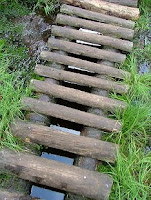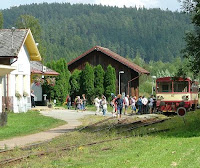
 Last weekend I went with my friend Ivo to the Adršpach-Teplice rocks in north-eastern Bohemia. These rocks are, along with places like the Český Raj and the caves of the Moravian Karst, among the most notable natural attractions of the Czech Republic. The rocks form a single nature reserve, but there are two distinct clusters of improbably eroded pinnacles, ridges and boulders. The northern ‘rock town’ is at the edge of Adršpach village, the second is closer to Teplice nad Metují, and they’re connected by a beautiful hiking trail through narrow and marshy Wolf Gorge.
Last weekend I went with my friend Ivo to the Adršpach-Teplice rocks in north-eastern Bohemia. These rocks are, along with places like the Český Raj and the caves of the Moravian Karst, among the most notable natural attractions of the Czech Republic. The rocks form a single nature reserve, but there are two distinct clusters of improbably eroded pinnacles, ridges and boulders. The northern ‘rock town’ is at the edge of Adršpach village, the second is closer to Teplice nad Metují, and they’re connected by a beautiful hiking trail through narrow and marshy Wolf Gorge.
 Our first hike was a simple loop around the Teplice rocks. To get to the rocks we followed a trail along a forested gully that offered glimpses of rock formations through the trees and the opportunity to climb 300 steps for views from the site of ruined Strmen castle. After 2km or so there’s a stone gate and after this the trees stop and the rock town proper begins. The formations have names like boar and dog, sphinx and the butchers’ cleaver and I could see a resemblance about half the time. There are several side tracks leading off the main trail, but you eventually come back towards the same stone gate through which you entered. The last part of the trail before this is the aptly named Siberia (Sibiř) a narrow shady gorge with the distinct microclimate that the name suggests. The walls of the gully were covered with mosses and ferns that are normally found only at much higher altitudes and on a sunny afternoon in late August we could clearly see our breath frosting up. Cool!
Our first hike was a simple loop around the Teplice rocks. To get to the rocks we followed a trail along a forested gully that offered glimpses of rock formations through the trees and the opportunity to climb 300 steps for views from the site of ruined Strmen castle. After 2km or so there’s a stone gate and after this the trees stop and the rock town proper begins. The formations have names like boar and dog, sphinx and the butchers’ cleaver and I could see a resemblance about half the time. There are several side tracks leading off the main trail, but you eventually come back towards the same stone gate through which you entered. The last part of the trail before this is the aptly named Siberia (Sibiř) a narrow shady gorge with the distinct microclimate that the name suggests. The walls of the gully were covered with mosses and ferns that are normally found only at much higher altitudes and on a sunny afternoon in late August we could clearly see our breath frosting up. Cool!
 The next morning we set out to hike the long Wolf Gorge up to the Adršpach end of the nature reserve. The gorge starts out more like a wide valley; much like the nearby approach to the Teplice rocks. There are glimpses of rocks through the trees and a stream flows alongside the yellow-marked walking trail. Then the stream turns to beer! Well, OK not really, but it has the look of a nice 12 degree yeast beer, doesn’t it? Ivo, who studied environmental sciences, explained that the bronze colour of the water is due to it having been filtered through peat marsh and the foam is from a plant known in Czech as Mydlice and in Latin as something-or-other saponarium. Apparently in the middle ages people used it to do their laundry.
The next morning we set out to hike the long Wolf Gorge up to the Adršpach end of the nature reserve. The gorge starts out more like a wide valley; much like the nearby approach to the Teplice rocks. There are glimpses of rocks through the trees and a stream flows alongside the yellow-marked walking trail. Then the stream turns to beer! Well, OK not really, but it has the look of a nice 12 degree yeast beer, doesn’t it? Ivo, who studied environmental sciences, explained that the bronze colour of the water is due to it having been filtered through peat marsh and the foam is from a plant known in Czech as Mydlice and in Latin as something-or-other saponarium. Apparently in the middle ages people used it to do their laundry.
 It wasn’t much further and we came upon the peat marshes themselves. Apparently 90% of the plant is dead and lies under the water level, but even the dead part is capable of absorbing moisture and nutrients. The gorge had narrowed by now and the trail was along raised wooden walkways. A jaunty gangplank across one end of the small lake (jezirko) marks the end of wolf gorge and the beginning of the Adršpach rocks.
It wasn’t much further and we came upon the peat marshes themselves. Apparently 90% of the plant is dead and lies under the water level, but even the dead part is capable of absorbing moisture and nutrients. The gorge had narrowed by now and the trail was along raised wooden walkways. A jaunty gangplank across one end of the small lake (jezirko) marks the end of wolf gorge and the beginning of the Adršpach rocks.
 The Adršpach rocks are the most visited part of the park with around 250,000 visitors per year, while Teplice receives around one-fifth as many. When we were there the place was full of Polish and German bus groups. The rock formations were no more spectacular than those at Teplice, so I think the Adršpach rocks are more popular because there’s more water here. Coming from the southern end like we did, you’ll come first to the imaginatively named ‘large waterfall’ and ‘small waterfall’. At one of them I saw this sign, which struck me as funny; “Warning. Splashing water!”
The Adršpach rocks are the most visited part of the park with around 250,000 visitors per year, while Teplice receives around one-fifth as many. When we were there the place was full of Polish and German bus groups. The rock formations were no more spectacular than those at Teplice, so I think the Adršpach rocks are more popular because there’s more water here. Coming from the southern end like we did, you’ll come first to the imaginatively named ‘large waterfall’ and ‘small waterfall’. At one of them I saw this sign, which struck me as funny; “Warning. Splashing water!”
 The trail then follows a loop through the rock formations equally as impressive (but not more so) than those at nearby Teplice. The most well-known and photographed formations are ones like the Mayor (Starosta), and the Great Panorama, but there dozens of other to explore and ponder, like the Organ Pipes, Medusa’s Head and the Guillotine. These rocks are also particularly popular with rockclimbers and even if you don’t see them climbing, you’ll notice their rings and couplings marking out seemingly impossible trails up sheer and smooth rock faces. There’s also a small rock chapel with the names of those who died while participating in their favourite sport.
The trail then follows a loop through the rock formations equally as impressive (but not more so) than those at nearby Teplice. The most well-known and photographed formations are ones like the Mayor (Starosta), and the Great Panorama, but there dozens of other to explore and ponder, like the Organ Pipes, Medusa’s Head and the Guillotine. These rocks are also particularly popular with rockclimbers and even if you don’t see them climbing, you’ll notice their rings and couplings marking out seemingly impossible trails up sheer and smooth rock faces. There’s also a small rock chapel with the names of those who died while participating in their favourite sport.
 Just inside the Adršpach entrance to the rocks is a lake in an old gravel pit on which it is possible to row in rented boats. Just outside you come to a huge carpark for 30 buses and 200cars and the small but busy Adršpach train station, where you can catch a red rattler back to Teplice at least once an hour for 16Kč.
Just inside the Adršpach entrance to the rocks is a lake in an old gravel pit on which it is possible to row in rented boats. Just outside you come to a huge carpark for 30 buses and 200cars and the small but busy Adršpach train station, where you can catch a red rattler back to Teplice at least once an hour for 16Kč.
 The final thing that Ivo and I undertook was a spot of cycling; a circumnavigation of the park by bicycle, to be precise. If I had one of those flash computers like Grant from Grant’s Bike Blog I could tell you all about average speeds and ascents and descents and stuff, but I don’t so I can’t. What I can tell you is that we covered about 25km, there were both steep and gentle hills to climb, steep and gentle hills to glide down and not-so-many rock formations to be seen through the thick forest. Despite my bike being better suited to the terrain, Ivo still beat me up all the hills and waited at the top of each for me to catch up. The final stretch back into Teplice though, was a long descent on a paved road; Whooooee! I beat Ivo this time, but I’m not sure how smart it was without a helmet. If my brake cable had chosen to give out just then, I’m pretty sure I’d be writing this from hospital.
The final thing that Ivo and I undertook was a spot of cycling; a circumnavigation of the park by bicycle, to be precise. If I had one of those flash computers like Grant from Grant’s Bike Blog I could tell you all about average speeds and ascents and descents and stuff, but I don’t so I can’t. What I can tell you is that we covered about 25km, there were both steep and gentle hills to climb, steep and gentle hills to glide down and not-so-many rock formations to be seen through the thick forest. Despite my bike being better suited to the terrain, Ivo still beat me up all the hills and waited at the top of each for me to catch up. The final stretch back into Teplice though, was a long descent on a paved road; Whooooee! I beat Ivo this time, but I’m not sure how smart it was without a helmet. If my brake cable had chosen to give out just then, I’m pretty sure I’d be writing this from hospital.
 As it was I survived to tell the tale and hike and bike another day. Now where should we go next? I bet Karlovy Vary is nice at this time of year…
As it was I survived to tell the tale and hike and bike another day. Now where should we go next? I bet Karlovy Vary is nice at this time of year…




















2 comments:
Wow that place looks cooool! Is it an easy day trip from Olomouc? I'm guessing Ivo had a car?
It's not close to Olomouc, but we took Ivo's new van up there which cut a bit of time off the trip, allowed us to take our bikes and gave Ivo a chance to run in his new motor.
Good trip overall.
Post a Comment